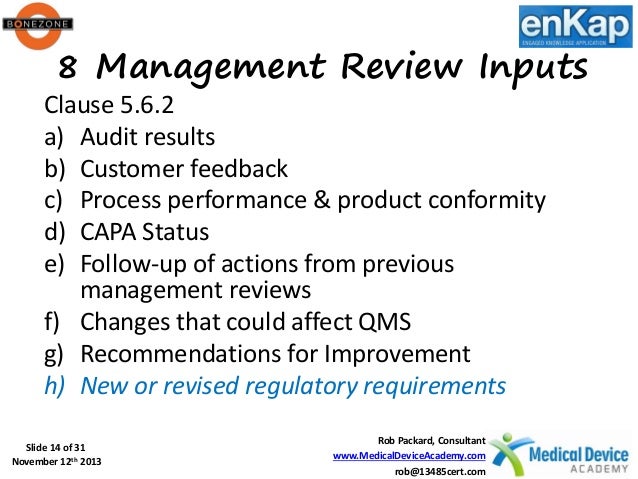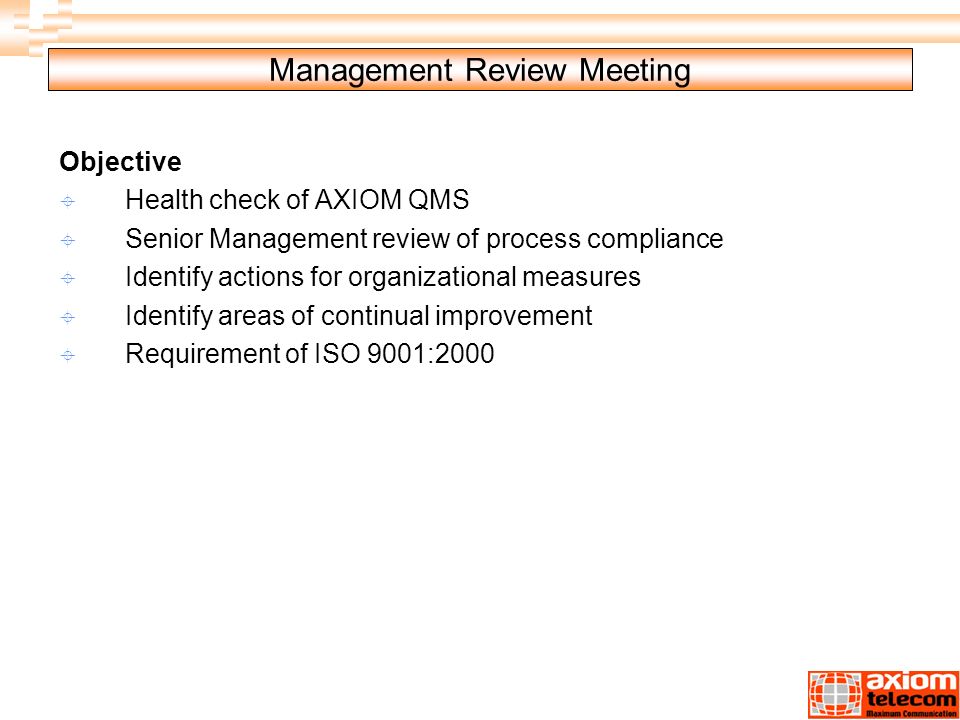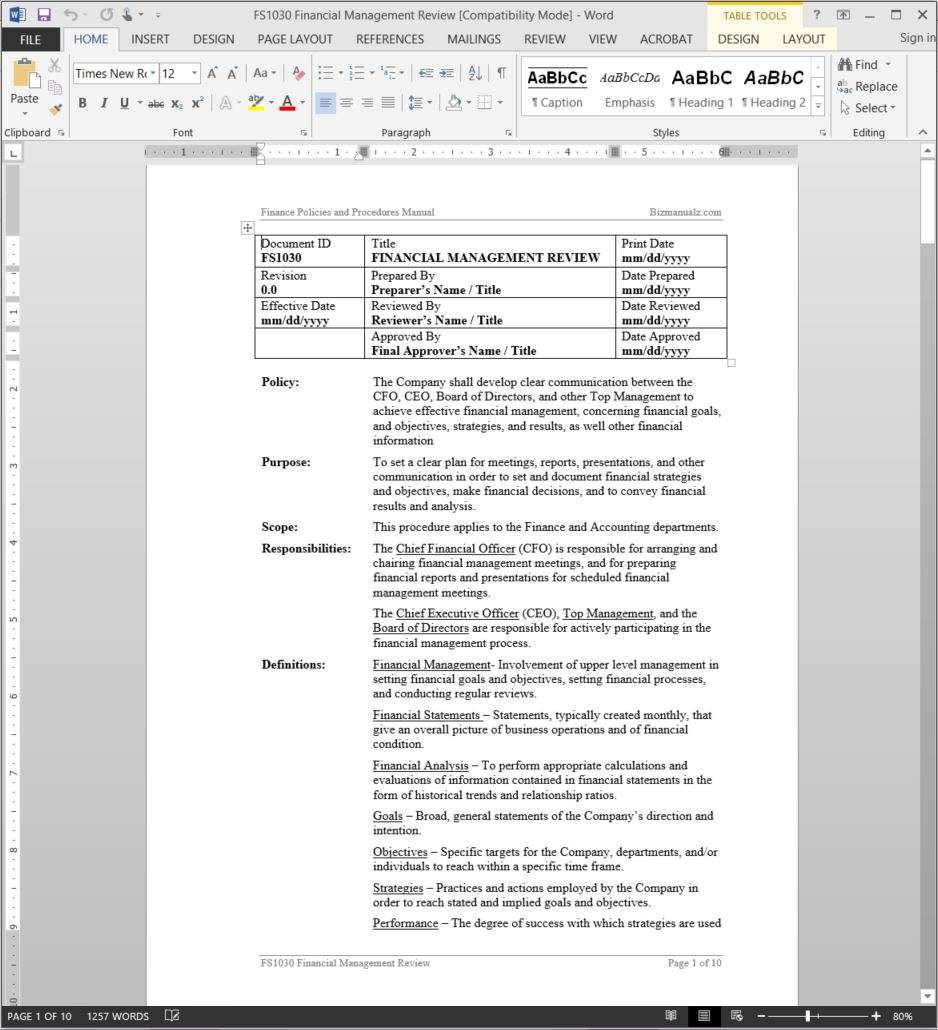RESPONSIBILITY AND AUTHORITY. The following will be responsible for the process of preparing for the Management Review Meeting: 5.1 CEO: 5.1.1 Assure the implementation of the MR policy. 5.1.2 Chair the MR meeting. 5.1.3 Invite members of the top management to the meeting.
9.0 Performance Evaluation
ISO Navigator Pro™ is a free tool that provides practical, expert guidance for businesses wishing to interpret and better implement the requirements of ISO 9001:2015, ISO 14001:2015 and ISO 45001:2018.
Our range of templates cover the requirements of ISO 9001:2015, ISO 14001:2015 and ISO 45001:2018, and offer an easy way to implement your next management system.
9.3 Management review
« Previous | Next »
ISO 9001 Background ISO 9001:2015 is the world’s foremost quality management standard, used by hundreds of thousands of organisations in over 170 countries around the globe. It sets out the essential requirements for a practical and effective Quality Management System (QMS). Introduction to the ISO 9001 Auditing Practices Group Feedback from users will be used by the ISO 9001 Auditing Practices Group to determine whether additional guidance documents should be developed, or if these current ones should be revised. Comments on the papers or presentations can be sent to the following email address. The revision of ISO 9001:2015 introduces a new 10 clause structure, many new requirements and many terms. Users will need to take into consideration that changes may be necessary to their QMS. BACKGROUND TO THE ISO 9001:2015 REVISION PROCESS.
9.3.1 Management review - general
The guidance shown on this page is relevant to ISO 9001, ISO 14001 and ISO 45001. Top management must periodically review the management system to ensure its continuing suitability, adequacy, and effectiveness. The frequency or intervals of the Top management’s formal review must be defined.
The management review must address the possible need for changes to policy, objectives, targets, and other elements of the management system. If you need a procedure and forms to help your business control its management review process, click here.

Here's what management systems stanards are really all about: defining a policy and creating a plan with relevant objectives. You then implement the system according to the plan and begin auditing, monitoring and measuring performance against the plan and reacting to your findings.
As such; management review meetings provide useful insight into the operation of the management system and its processes to enable Top management to respond to issues and to recommend improvements.
Who should attend management review meetings?
As per Clause 5.1 of the standards, it is important that a member of Top management chairs the management review meetings. It is imperative that everyone involved with the management review process fully understand and appreciate the management review requirements from Clause 9.3.
Other attendees at management review meetings should include functional management, line management, process owners, process champions, lead process users, and action owners within the scope of the quality management system, as appropriate, and the internal auditor(s) should also attend.
The management review process must ensure that the necessary information is collected ahead of time to allow management to effectively carry out an evaluation prior to the meeting. Note taking and action recording is often undertaken by the Management Representative who will forward minutes of the management review meeting to those on the distribution list and to those with actions.
How often should we have management review meetings?
There are no specified time periods applicable to conducting management review meetings. However, they should be organized with a frequency and format commensurate to the level of risks and the complexity of your organization.

Critical management review agenda items, such as; process performance, customer feedback and monitoring and measuring results should be reviewed monthly, while less critical agenda items, such as reviewing the quality policy and objectives should be undertaken less frequently, perhaps every quarter.
This approach minimizes the length of each management review meeting, covers all of the required management review inputs over the duration of the management review programme, and allows for the analysis of trends in data while the information is contemporary. Our management system templates include this type of management review programme, you can download a copy for free.
Annual management reviews are insufficient in frequency to be able react to any issues effectively. Performance metrics should be monitored with varying frequencies, some hourly, some daily, some weekly and some monthly. Management cannot wait for six months to respond, if they do, it will be too late.
Top management might conduct weekly meetings in which they review metrics and objectives to determine if any corrective action is required. The process owner is then responsible for reporting close out progress in the meeting a week later. Every time management convenes to review and react to performance, it is considered as a management review.
Some companies have multiple review levels, whereby, each review may require multiple subjects and rely upon multiple metrics as inputs. Sometimes subjects are reviewed at more than one level, e.g. production numbers might be reviewed by the Production teams during daily production meetings and then by senior management, possibly weekly.
9.3.2 Management review - inputs
This now includes additional requirements for your organization to have a structured management review process that includes discussion of internal and external issue changes, and its potential effect on the strategic direction of your organization. The management review process should focus on the following inputs:
Quality management review inputs
- Status of follow-up actions (open/closed) from the previous management review
- Changes in internal and external issues (Clause 4.1 & Clause 4.2);
- Customer feedback (Clause 9.1.2);
- Performance indicators and objectives (Clause 6.2);
- Process performance and product conformity (Clause 8.1);
- Non-conformities and corrective actions (Clause 10.2)
- Monitoring measuring results (Clause 9.2);
- Results of audits and inspections (Clause 9.1);
- External providers (Clause 8.4);
- Resources (Clause 7.1);
- Risk and opportunities (Clause 6.1);
- Opportunities for improvement (Clause 10.1);
- Changes affecting the QMS (Clause 6.3);
- Review of QMS policy & Objectives (Clause 5.2);
- Review of action items.
Health and safety management review inputs
- The status of actions from previous management review meeting;
- Changes in:
- The needs and expectations of interested parties (Clause 4.2);
- Legal requirements and other requirements (Clause 6.1.3);
- Risks and opportunities (Clause 6.1.1).
- The extent to which the policy and objectives have been met (Clause 5.2 & Clause 6.2.2);
- Information on the OHS performance, including trends in:
- Incidents, nonconformities, corrective actions and continual improvement (Clause 10.2);
- Monitoring and measurement results (Clause 9.1);
- Results of evaluation of compliance with legal requirements and other requirements (Clause 9.1.2);
- Audit results (Clause 9.2);
- Consultation and participation of workers (Clause 5.4);
- Risk and opportunities (Clause 6.1.1).
- The adequacy of resources for maintaining an effective OHS management system (Clause 7.1);
- Relevant communication(s) with interested parties (Clause 7.4.3);
- Opportunities for continual improvement (Clause 10.3);
- Review of action items.
Environmental management review inputs
- The status of actions from previous management reviews considered during management review;
- Changes in:
- External and internal issues that are relevant to the EMS (Clause 4.1 & Clause 4.2);
- Compliance obligations and other expectations of interested parties (Clause 6.1.3);
- Significant environmental aspects (Clause 6.1.2);
- Risks and opportunities (Clause 6.1.1).
- The extent to which objectives have been met (Clause 6.2);
- Information on our organization’s environmental performance, including trends in:
- Non-conformities and corrective actions (Clause 10.2);
- Monitoring and measurement results (Clause 9.1.1);
- Compliance obligations fulfilment (Clause 9.1.2);
- Audit results (Clause 9.2).
- The adequacy of resources (Clause 7.1);
- Communications from interested parties, including complaints (Clause 7.4.1);
- Opportunities for continual improvement (Clause 10.3);
- Review of action items.
Observations, conclusions, and recommendations for further necessary action from the review must be recorded. If any corrective action must be taken, Top management should follow up to ensure that the action was effectively implemented.

9.3.3 Management review - outputs
Management review results should be summarized, specifying management commitments, directives and action items. Action items should specify responsible individuals and target completion dates. Affected individuals include those impacted by or responsible for addressing findings. You should seek and record evidence of outputs from the management review process, there should be evidence of decisions regarding:
- Process improvement actions;
- Management system improvement actions;
- Product and service improvement actions;
- Resource provision actions;
- Revised business plans and budgets;
- Revised objectives and KPIs/SPIs;
- Amendments to policies;
- Management meeting minutes.
Any corrective outputs from the management review meeting should be actioned as necessary through the nonconformity and corrective action system. Auditors should expect to evidence the same outputs from management reviews as at present. However, they should note that the results of management reviews can now be held in any format that the organization chooses.
Management review meeting minutes, agenda, programme and presentations should be retained as documented information. Action items should be developed from the findings of the management review, while results and action items from the management review should be documented, communicated to affected individuals, and tracked to completion.
« Previous | Next »
More information on PDCA
Planning
ISO 9001:2015 | ISO 14001:2015 | ISO 45001:2018 |
| 4.1 Organizational Context | 4.1 Organizational Context | 4.1 Organizational Context |
| 4.2 Relevant Interested Parties | 4.2 Relevant Interested Parties | 4.2 Relevant Interested Parties |
| 4.3 Management System Scope | 4.3 Management System Scope | 4.3 Management System Scope |
| 4.4 QMS Processes | 4.4 EMS Processes | 4.4 OH&S Management System |
ISO 9001:2015 | ISO 14001:2015 | ISO 45001:2018 |
| 5.1 Leadership & Commitment | 5.1 Leadership & Commitment | 5.1 Leadership & Commitment |
| 5.2 Quality Policy | 5.2 Environmental Policy | 5.2 OH&S Policy |
| 5.3 Roles, Responsibilities & Authorities | 5.3 Roles, Responsibilities & Authorities | 5.3 Roles, Responsibilities & Authorities |
| 5.4 Consultation & Participation |
ISO 9001:2015 | ISO 14001:2015 | ISO 45001:2018 |
| 6.1.1 Address Risks & Opportunities | 6.1.1 Address Risks & Opportunities | 6.1.1 Address Risks & Opportunities |
| 6.2.1 Quality Objectives | 6.1.2 Environmental Aspects | 6.1.2 Hazard Identifcation |
| 6.2.2 Planning to Achieve Objectives | 6.1.3 Compliance Obligations | 6.1.3 Legal & Other Requirements |
| 6.3 Planning for Change | 6.1.4 Planning Action | 6.1.4 Planning Action |
| 6.2.1 Environmental Objectives | 6.2.1 OH&S Objectives | |
| 6.2.2 Planning to Achieve Objectives | 6.2.2 Planning to Achieve Objectives |
Doing
ISO 9001:2015 | ISO 14001:2015 | ISO 45001:2018 |
| 7.1.1 Resources - General | 7.1 Resources | 7.1 Resources |
| 7.1.2 People | 7.2 Competence | 7.2 Competence |
| 7.1.3 Infrastructure | 7.3 Awareness | 7.3 Awareness |
| 7.1.4 Operational Environment | 7.4.1 Communcation - General | 7.4.1 Communcation - General |
| 7.1.5 Monitoring & Measuring | 7.4.2 Internal Communcation | 7.4.2 Internal Communcation |
| 7.1.6 Organizational Knowledge | 7.4.3 External Communcation | 7.4.3 External Communcation |
| 7.2 Competence | 7.5 Documented Information | 7.5 Documented Information |
| 7.3 Awareness | ||
| 7.4 Communcation | ||
| 7.5 Documented Information |
ISO 9001:2015 | ISO 14001:2015 | ISO 45001:2018 |
| 8.1 Operational Planning & Control | 8.1 Operational Planning & Control | 8.1.1 General |
| 8.2.1 Customer Communication | 8.2 Emergency Preparedness | 8.1.2 Eliminating Hazards |
| 8.2.2 Determining Requirements | 8.1.3 Management of Change | |
| 8.2.3 Reviewing Requirements | 8.1.4 Outsourcing | |
| 8.2.4 Changes in Requirements | 8.2 Emergency Preparedness | |
| 8.3.1 Design Development - General | ||
| 8.3.2 Design Development - Planning | ||
| 8.3.3 Design Development - Inputs | ||
| 8.3.4 Design Development - Controls | ||
| 8.3.5 Design Development - Outputs | ||
| 8.3.6 Design Development - Changes | ||
| 8.4.1 External Processes - General | ||
| 8.4.2 Purchasing Controls | ||
| 8.4.3 Purchasing Information | ||
| 8.5.1 Production & Service Provision | ||
| 8.5.2 Identification & Traceability | ||
| 8.5.3 3rd Party Property | ||
| 8.5.4 Preservation | ||
| 8.5.5 Post-delivery Activities | ||
| 8.5.6 Control of Changes | ||
| 8.6 Release of Products & Services | ||
| 8.7 Nonconforming Outputs |
Checking
ISO 9001:2015 | ISO 14001:2015 | ISO 45001:2018 |
| 9.1.1 Performance Evaluation | 9.1.1 Performance Evaluation | 9.1.1 Performance Evaluation |
| 9.1.2 Customer Satisfaction | 9.1.2 Evaluation of Compliance | 9.1.2 Evaluation of Compliance |
| 9.1.3 Analysis & Evaluation | 9.2 Internal Audit | 9.2 Internal Audit |
| 9.2 Internal Audit | 9.3 Management Review | 9.3 Management Review |
| 9.3 Management Review |
Acting

ISO 9001:2015 | ISO 14001:2015 | ISO 45001:2018 |
| 10.1 Improvement - General | 10.1 Improvement - General | 10.1 Improvement - General |
| 10.2 Nonconformity & Corrective Action | 10.2 Nonconformity & Corrective Action | 10.2 Incident, Nonconformity & Corrective Action |
| 10.3 Continual Improvement | 10.3 Continual Improvement | 10.3 Continual Improvement |
Want to know more?
Iso Management Review Template Ppt
- Client list - who's using our templates?
- How the templates are formatted and download examples
- What's the difference between a process and a procedure?
Iso 9001 Management Review Meeting Presentation Background Report
SSL certification
Iso 9001 Management Review Meeting Presentation Background Form
A certificate guarantees the information your internet browser is receiving now originates from the expected domain - https://www.iso9001help.co.uk. It guarantees that when you make a purchase, sensitive data is encrypted and sent to the right place, and not to a malicious third-party.
Free PDCA guidance
Iso 9001 Management Review Meeting Presentation Background Template
ISO Navigator™ is our FREE online training tool that shows you how to apply the principles of PDCA to your operations. We also offer many helpful templates that get you on the road to documenting your management system, please visit the download page.